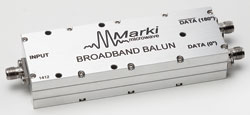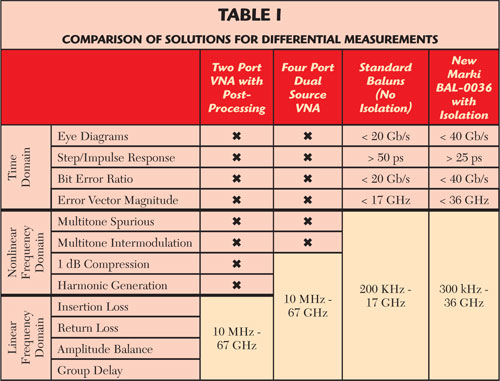
Microwave and signal integrity engineers face difficult choices when deciding how to perform differential measurements. Many test solutions are inaccurate, expensive, limited in bandwidth, and inconvenient. The broadband nature and high isolation of the new BAL-0026 and BAL-0036 baluns from Marki Microwave eliminate these difficult decisions by providing an all-in-one test solution for all classes of differential system measurements. With frequency coverage from 300 kHz to 36 GHz (BAL-0036) or 26 GHz (BAL-0026), typical balance of 0.5 dB/5°, and 25 dB typical isolation, these new baluns provide the differential test capability necessary for any requirement. See Table 1 for a comparison of technologies.
When designing a differential device or system, an engineer must decide how to properly characterize performance. For a device such as an amplifier, this includes linear frequency domain parameters (S-parameters and the like), nonlinear frequency parameters (spurious generation, P1dB), and potentially time domain characteristics (rise time, eye diagrams). While any of these can be evaluated by terminating one side of the differential inputs and/or outputs with a 50 ohm load, only linear S-parameters can be measured confidently using this method. If only linear S-parameters are desired for a device, they can be measured and post-calculated using a two-port VNA.

The proper method for measuring the nonlinear and time domain response of a system, however, is with differential excitation. This can be provided, at significant additional expense, using a dual-source four-port VNA. Unfortunately, this only extends the measurement capability of the VNA to single frequency excitations, which is suitable for testing 1 dB compression and single tone harmonic generation, but not for more general parameters such as multi-tone intermodulation or spurious generation. Furthermore, it does not provide measurement capability for any real-world time domain testing with actual data. This requires a differential to single-ended mode converters.
There are two major options for such a converter: the balun and the 180° hybrid coupler. The advantage that baluns have are that they can have frequency coverage to very low frequencies (in the kHz range), which makes them suitable for baseband data. They have been limited, however, usually to frequencies below 10 GHz on the high end. The advantage of 180° hybrid couplers is that they can operate at high frequency (65 GHz or higher), but they cannot operate below 2 GHz, making them unsuitable for baseband data.
Hybrid couplers also have isolation between output ports, while most balun designs do not. Lack of isolation between the positive and negative balanced ports can cause erroneous measurements in both the frequency and time domain. It can also cause significant errors for testing of devices that do not have a perfect 50 Ω match.
The new baluns from Marki Microwave merge the best features of each device into one all-purpose unit. The broadband 300 kHz to 26/36 GHz operation makes the BAL-0036 suitable for all classes of signals, including baseband data, narrowband data, and high frequency single tone testing. The combination of excellent balance, isolation, low return loss, and flat insertion loss means that the baluns are transparent to the user during measurements.
The typical balance of the new BAL-0036 is ±3° of phase balance and ±0.5 dB of amplitude balance for frequencies up to 36 GHz. This translates into 8.6 ps of typical differential group delay ripple, and 6 percent of typical differential voltage variation across the band. The differential insertion loss increases from ~3 dB at low frequency to 5 dB at 36 GHz with low group delay ripple, making it more than capable of transmitting 40 Gb/s data with open eyes.
Differential signaling is generally preferred to single ended signaling because it has inherent immunity from electromagnetic interference (EMI) noise. Signal integrity engineers are adopting differential signaling for more applications and in higher frequency designs, as more stringent dynamic range requirements require the elimination of EMI noise. Despite this clear advantage, adoption of differential signaling is hampered by the dearth of options for testing differential devices and systems at frequencies above 10 GHz. By providing convenient and accurate measurements of all differential parameters at a fraction of the cost of a dual source VNA, the broadband balun could serve as the cornerstone of any laboratory differential testing capability.
Marki Microwave,
Morgan Hill, CA
info@markimicrowave.com
www.markimicrowave.com
